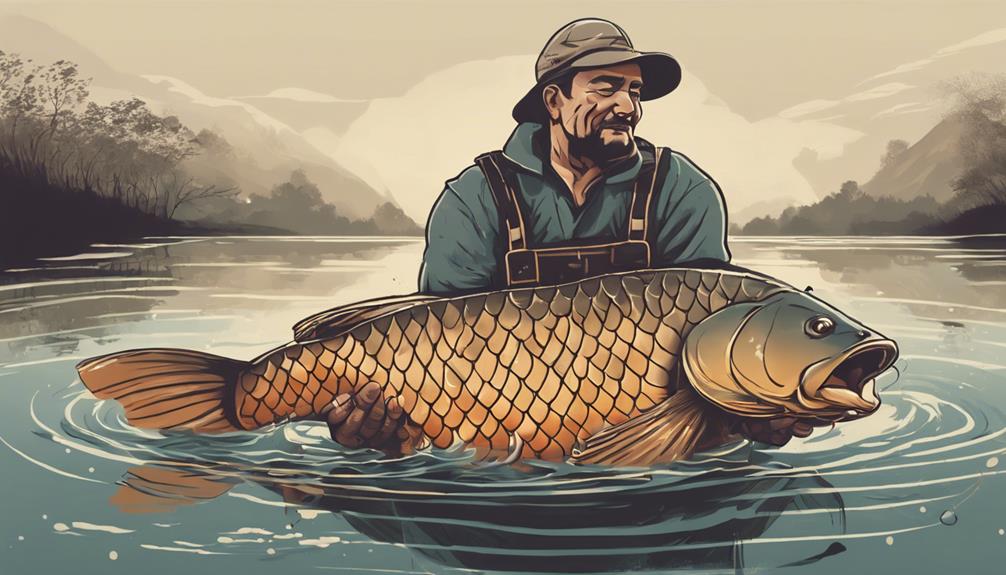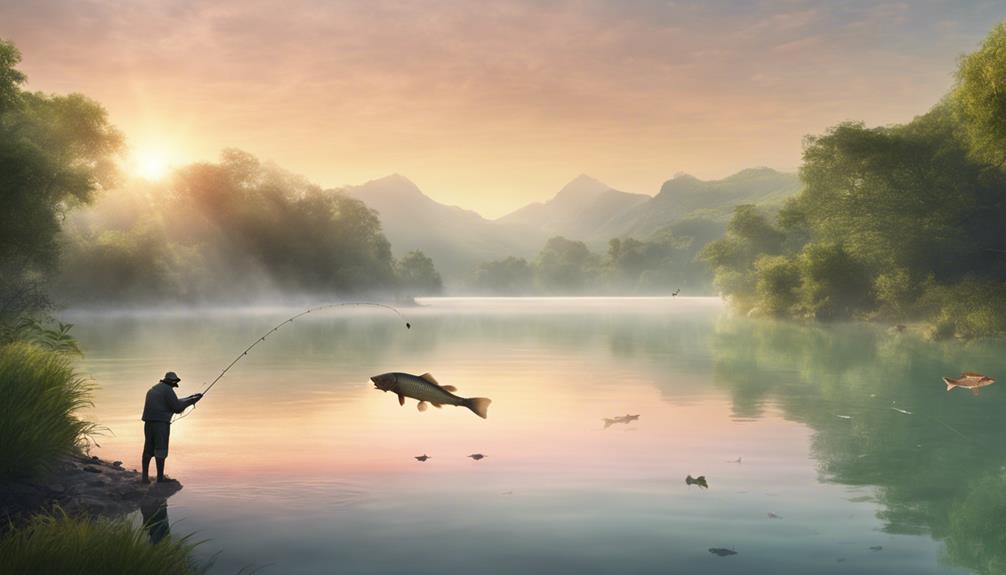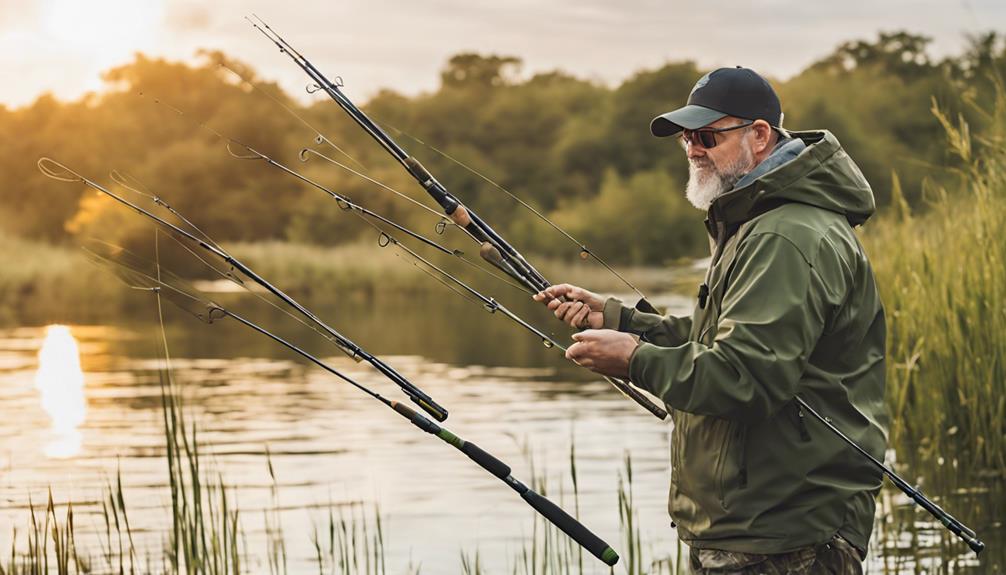Unlock the mysteries of successful big carp catching by mastering essential gear, bait selection, and fishing techniques. Understand carp behavior patterns, locate prime fishing spots, exercise patience, and handle big carp properly. Utilize tips for consistent catches. Gain insights into maximizing your success with big carp by fine-tuning these crucial aspects.
Essential Gear for Big Carp Fishing
When targeting big carp, having the appropriate gear is crucial to increase your chances of a successful catch. Tackle selection plays a vital role in big carp fishing. Opt for sturdy tackle that can handle the weight and strength of these large fish. Choose a reel with a smooth drag system to prevent line breakage during intense fights. Braided line is recommended for its strength and sensitivity, allowing you to feel even the slightest bites from cautious carp. Fluorocarbon leaders can also be beneficial as they're nearly invisible underwater, reducing the chances of spooking the carp.
Rod and reel choices are paramount when pursuing big carp. Select a rod with a test curve between 2.75lbs and 3.5lbs to provide the necessary backbone for casting heavy rigs and controlling the fish during the battle. Pair this with a quality baitcasting reel that has a high line capacity to accommodate the long runs big carp are known for. A bait-feeder reel can be a great asset, allowing carp to take the bait without feeling the resistance of the line until you engage the main drag system. This feature can prevent cautious carp from dropping the bait prematurely.
Choosing the Best Bait for Carp
Selecting the most effective bait for carp involves considering various factors to optimize your chances of a successful catch. When it comes to bait selection, understanding the preferences of carp is crucial. Carp are known to be omnivorous, feeding on a wide range of food sources including insects, plant matter, and small fish. Therefore, using a bait that mimics these natural food sources can significantly increase your chances of attracting carp.
Various bait types can be effective in carp fishing. Popular choices include boilies, corn, pellets, and bread. Boilies are specially designed carp baits that come in different flavors and sizes, offering versatility in different fishing conditions. Corn is a cost-effective option that carp find irresistible, especially in waters where corn is a natural food source. Pellets are another favorite among carp anglers, providing a concentrated burst of attraction. Bread, though simple, can be a highly effective bait when fishing in waters where carp are accustomed to feeding on bread.
When setting up your rig, consider the fishing strategies you plan to employ. Different rigs work best with specific bait types. For example, a hair rig is commonly used with boilies, allowing the bait to be presented naturally while increasing hooking potential. On the other hand, a method feeder rig is ideal for using pellets as bait, providing a consistent stream of attractants to draw in carp. Understanding the relationship between bait types and rig setups is essential for maximizing your chances of a successful carp catch.
Mastering Carp Fishing Techniques
To excel in carp fishing, mastering a variety of techniques is essential for increasing your success rate and honing your skills. Understanding carp feeding behaviors and employing the right rigs are crucial elements in your pursuit of big carp. Here are four key techniques to help you become a more successful carp angler:
- Boilie Placement: Carp are known to be cautious feeders, so the placement of your boilie is critical. Experiment with different depths and distances from the shore to find the optimal feeding zone.
- PVA Bag Tactics: Using PVA bags to present your bait can be highly effective. These bags dissolve in water, leaving your baited hook and rig perfectly presented near the lake bed where carp often feed.
- Zig Rig Fishing: When carp are feeding mid-water or near the surface, zig rig fishing can be a game-changer. Adjusting the depth of your bait to match the carp's feeding level increases your chances of a successful catch.
- Spodding Technique: Spodding involves the use of a spod to accurately bait a specific area. By creating a feeding spot, you can attract carp to your rig and increase your chances of a bite.
Understanding Carp Behavior Patterns
Understanding the intricate behavior patterns of carp is pivotal for successful angling endeavors. Carp feeding habits play a significant role in their behavior. These fish are known to be omnivorous, feeding on a variety of food sources such as insects, crustaceans, plants, and even small fish. By understanding what carp feed on in a particular water body, anglers can tailor their bait selection to increase their chances of a successful catch.
In addition to feeding habits, carp migration habits are essential to comprehend. Carp are known to move in response to factors such as water temperature, oxygen levels, and spawning requirements. During colder months, they tend to move to deeper waters where temperatures are more stable. As spring approaches, carp migrate to shallower areas to spawn. Knowing these migration patterns can help anglers anticipate where carp are likely to be at different times of the year.
Researching and observing carp behavior patterns in different seasons and water conditions can provide valuable insights for anglers looking to improve their catch rates. By studying carp feeding preferences and migration habits, anglers can strategically plan their fishing trips, increasing their chances of landing that prized big carp.
Locating Prime Carp Fishing Spots
In identifying optimal locations for carp fishing, consider factors such as water depth, vegetation cover, and underwater structures. When targeting big carp, it's crucial to focus on specific areas where these elusive fish are more likely to be found.
Here are some key strategies to enhance your chances of success:
- Understanding Water Depth: Carp tend to prefer areas with varying water depths. Look for spots where shallow waters transition into deeper regions as these locations often attract carp seeking different temperatures and food sources.
- Assessing Vegetation Cover: Carp are known to seek refuge in areas with abundant vegetation cover. Pay close attention to areas with lily pads, reeds, or submerged plants as these provide shelter and a natural food source for carp.
- Identifying Underwater Structures: Carp are naturally drawn to underwater structures such as submerged logs, rocks, or man-made features like piers and bridges. These structures offer hiding spots for carp and can be prime feeding areas.
- Mapping Hotspots: Use technology like fish finders or underwater cameras to map out hotspots where carp are congregating. By pinpointing these areas, you can maximize your chances of landing that prized big carp.
Patience: Key to Big Carp Success
Patience plays a pivotal role in achieving success when targeting big carp in fishing expeditions. Developing patience is crucial as big carp are known for their cautious nature, often requiring extended periods to fully commit to bait. Research suggests that big carp are more likely to be caught by anglers who exhibit patience in their fishing strategy.
To develop patience when targeting big carp, it's essential to understand their behavior patterns. Big carp are known to be cautious and selective feeders, which means they may take longer to inspect bait before deciding to strike. By observing and studying the behavior of big carp in different conditions, anglers can adapt their fishing strategy to align with the patience required for a successful catch.
Incorporating patience into your fishing strategy involves techniques such as maintaining a consistent baiting pattern, allowing enough time for the carp to investigate the bait, and resisting the urge to reel in too quickly. Understanding that big carp may need more time to fully commit to the bait can significantly increase your chances of a successful catch.
Handling and Releasing Big Carp

To safely handle and release big carp after catching them, it's essential to follow proper fish handling techniques to ensure their well-being and survival. Carp conservation relies heavily on angler responsibility, making it crucial to handle these fish ethically. Here are some key practices to consider:
- Minimize Air Exposure: Limiting the time a big carp spends out of the water can significantly enhance its chances of survival. Excessive air exposure can lead to stress and decreased oxygen levels in the fish, potentially harming its health.
- Use Wet Hands or Gloves: When handling big carp, ensure your hands are wet or wear gloves to protect the fish's delicate slime layer. This slime coat acts as a protective barrier against infections and parasites, making it vital for the carp's well-being.
- Support the Fish Properly: When lifting a big carp, support its weight evenly with both hands, avoiding excessive pressure on its organs. Proper support minimizes the risk of internal injuries and ensures a safer handling process.
- Revive Before Release: If a big carp appears exhausted after the fight, take the time to revive it before letting it go. Hold the fish upright in the water, allowing it to regain its strength and swim away on its own, promoting a successful and ethical release.
Tips for Consistent Big Carp Catches
For consistent big carp catches, employing strategic bait placement and utilizing specialized fishing rigs can significantly increase your success rate. Understanding carp feeding habits is crucial in maximizing your chances of a successful catch. Carp are bottom feeders and tend to forage for food in muddy or weedy areas where natural food sources are abundant. By placing your bait strategically in these areas, such as near underwater structures or along the edges of weed beds, you can attract big carp more effectively.
Weather impact plays a significant role in carp behavior and feeding patterns. Carp are known to be more active and responsive to bait when the weather is stable and mild. High pressure and calm conditions are ideal for carp fishing as the fish are more likely to feed actively during these times. On the other hand, extreme weather fluctuations, such as sudden drops in temperature or heavy rainfall, can make carp more cautious and less inclined to feed.
Incorporating this knowledge into your fishing strategy can help you achieve consistent big carp catches. By adapting your bait placement and fishing techniques to align with carp feeding habits and weather conditions, you can enhance your overall success in targeting and landing big carp.
Frequently Asked Questions
How Do Weather Conditions Impact Big Carp Fishing Success?
When big carp fishing, weather conditions play a crucial role in your success. The right bait selection is key in enticing these fish, especially during specific weather patterns.
Moon phases can also influence carp behavior, impacting your chances of a successful catch.
Additionally, water clarity can affect how visible your bait is to the carp. Understanding these factors can give you an edge in your fishing endeavors.
What Are the Best Times of Day to Fish for Big Carp?
When fishing for big carp, the best times of day are typically during dawn and dusk. During these periods, fish are more active, increasing your chances of a successful catch.
Moon phases can also play a role in fish activity, with full moons often leading to heightened feeding behavior.
It's essential to consider bait selection and fishing techniques to maximize your success during these optimal fishing times.
Are There Any Specific Rituals or Superstitions for Big Carp Catching?
When fishing for big carp, some anglers follow specific rituals or superstitions. These can include carrying lucky charms or performing certain rituals before casting their lines.
While some may view these practices as mere myths, others believe they can bring good luck and increase their chances of a successful catch.
Whether based on tradition or personal belief, incorporating these superstitions can add an element of excitement and anticipation to your fishing experience.
Can Underwater Topography Affect Big Carp Behavior?
Underwater topography can greatly influence big carp behavior. The layout of the underwater habitat, including features like drop-offs, weed beds, and submerged structures, can impact where carp congregate and feed.
Topographical features create diverse feeding areas, affecting big carp feeding habits. Understanding these underwater landscapes is crucial for successful big carp fishing, as it allows you to target specific areas where these prized fish are likely to be more active and feeding.
Is There a Way to Predict Big Carp Movements in Different Seasons?
To predict big carp movements in different seasons, you can observe seasonal patterns and behavioral cues. By tracking movements, you may notice trends in where the carp are located during specific times of the year.
Pay attention to factors like water temperature, food availability, and spawning periods as they can influence the movements of big carp. Understanding these patterns can help you anticipate where to find them throughout the changing seasons.
Conclusion
To consistently catch big carp, anglers need to follow key steps and tips, which include having the right gear, choosing the best bait, mastering fishing techniques, understanding carp behavior, locating prime fishing spots, practicing patience, and handling and releasing the fish properly. By incorporating these strategies, anglers can enhance their chances of success and have a fulfilling big carp fishing experience.
Research and knowledge play a crucial role in unlocking the secrets to successful big carp catching. Anglers should invest time in understanding the habits and preferences of carp, as well as staying informed about the latest gear and techniques. This knowledge will empower anglers to make informed decisions and adapt their strategies based on the conditions they encounter on the water.



